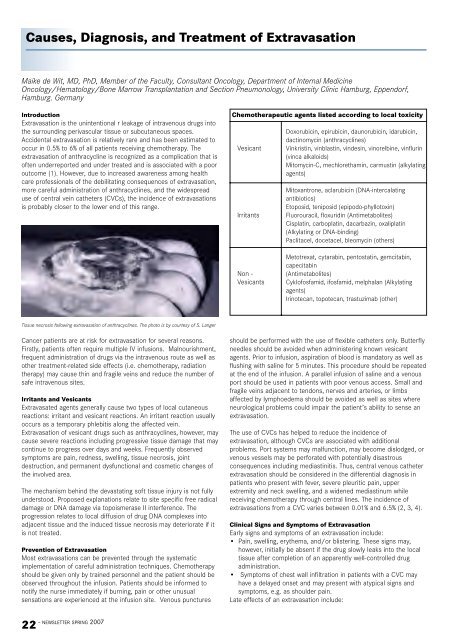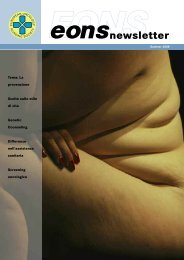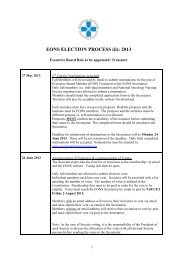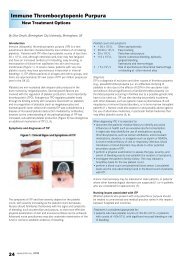Causes, Diagnosis, and Treatment of Extravasation - the European ...
Causes, Diagnosis, and Treatment of Extravasation - the European ...
Causes, Diagnosis, and Treatment of Extravasation - the European ...
You also want an ePaper? Increase the reach of your titles
YUMPU automatically turns print PDFs into web optimized ePapers that Google loves.
<strong>Causes</strong>, <strong>Diagnosis</strong>, <strong>and</strong> <strong>Treatment</strong> <strong>of</strong> <strong>Extravasation</strong>Maike de Wit, MD, PhD, Member <strong>of</strong> <strong>the</strong> Faculty, Consultant Oncology, Department <strong>of</strong> Internal MedicineOncology/Hematology/Bone Marrow Transplantation <strong>and</strong> Section Pneumonology, University Clinic Hamburg, Eppendorf,Hamburg. GermanyIntroduction<strong>Extravasation</strong> is <strong>the</strong> unintentional r leakage <strong>of</strong> intravenous drugs into<strong>the</strong> surrounding perivascular tissue or subcutaneous spaces.Accidental extravasation is relatively rare <strong>and</strong> has been estimated tooccur in 0.5% to 6% <strong>of</strong> all patients receiving chemo<strong>the</strong>rapy. Theextravasation <strong>of</strong> anthracycline is recognized as a complication that is<strong>of</strong>ten underreported <strong>and</strong> under treated <strong>and</strong> is associated with a pooroutcome (1). However, due to increased awareness among healthcare pr<strong>of</strong>essionals <strong>of</strong> <strong>the</strong> debilitating consequences <strong>of</strong> extravasation,more careful administration <strong>of</strong> anthracyclines, <strong>and</strong> <strong>the</strong> widespreaduse <strong>of</strong> central vein ca<strong>the</strong>ters (CVCs), <strong>the</strong> incidence <strong>of</strong> extravasationsis probably closer to <strong>the</strong> lower end <strong>of</strong> this range.Chemo<strong>the</strong>rapeutic agents listed according to local toxicityVesicantIrritantsDoxorubicin, epirubicin, daunorubicin, idarubicin,dactinomycin (anthracyclines)Vinkristin, vinblastin, vindesin, vinorelbine, vinflurin(vinca alkaloids)Mitomycin-C, mechlorethamin, carmustin (alkylatingagents)Mitoxantrone, aclarubicin (DNA-intercalatingantibiotics)Etoposid, teniposid (epipodo-phyllotoxin)Fluorouracil, floxuridin (Antimetabolites)Cisplatin, carboplatin, dacarbazin, oxaliplatin(Alkylating or DNA-binding)Paclitacel, docetacel, bleomycin (o<strong>the</strong>rs)Non -VesicantsMetotrexat, cytarabin, pentostatin, gemcitabin,capecitabin(Antimetabolites)Cykl<strong>of</strong>osfamid, ifosfamid, melphalan (Alkylatingagents)Irinotecan, topotecan, trastuzimab (o<strong>the</strong>r)Tissue necrosis following extravasation <strong>of</strong> anthracyclines. The photo is by courtesy <strong>of</strong> S. LangerCancer patients are at risk for extravasation for several reasons.Firstly, patients <strong>of</strong>ten require multiple IV infusions. Malnourishment,frequent administration <strong>of</strong> drugs via <strong>the</strong> intravenous route as well aso<strong>the</strong>r treatment-related side effects (i.e. chemo<strong>the</strong>rapy, radiation<strong>the</strong>rapy) may cause thin <strong>and</strong> fragile veins <strong>and</strong> reduce <strong>the</strong> number <strong>of</strong>safe intravenous sites.Irritants <strong>and</strong> VesicantsExtravasated agents generally cause two types <strong>of</strong> local cutaneousreactions: irritant <strong>and</strong> vesicant reactions. An irritant reaction usuallyoccurs as a temporary phlebitis along <strong>the</strong> affected vein.<strong>Extravasation</strong> <strong>of</strong> vesicant drugs such as anthracyclines, however, maycause severe reactions including progressive tissue damage that maycontinue to progress over days <strong>and</strong> weeks. Frequently observedsymptoms are pain, redness, swelling, tissue necrosis, jointdestruction, <strong>and</strong> permanent dysfunctional <strong>and</strong> cosmetic changes <strong>of</strong><strong>the</strong> involved area.The mechanism behind <strong>the</strong> devastating s<strong>of</strong>t tissue injury is not fullyunderstood. Proposed explanations relate to site specific free radicaldamage or DNA damage via topoismerase II interference. Theprogression relates to local diffusion <strong>of</strong> drug DNA complexes intoadjacent tissue <strong>and</strong> <strong>the</strong> induced tissue necrosis may deteriorate if itis not treated.Prevention <strong>of</strong> <strong>Extravasation</strong>Most extravasations can be prevented through <strong>the</strong> systematicimplementation <strong>of</strong> careful administration techniques. Chemo<strong>the</strong>rapyshould be given only by trained personnel <strong>and</strong> <strong>the</strong> patient should beobserved throughout <strong>the</strong> infusion. Patients should be informed tonotify <strong>the</strong> nurse immediately if burning, pain or o<strong>the</strong>r unusualsensations are experienced at <strong>the</strong> infusion site. Venous puncturesshould be performed with <strong>the</strong> use <strong>of</strong> flexible ca<strong>the</strong>ters only. Butterflyneedles should be avoided when administering known vesicantagents. Prior to infusion, aspiration <strong>of</strong> blood is m<strong>and</strong>atory as well asflushing with saline for 5 minutes. This procedure should be repeatedat <strong>the</strong> end <strong>of</strong> <strong>the</strong> infusion. A parallel infusion <strong>of</strong> saline <strong>and</strong> a venousport should be used in patients with poor venous access. Small <strong>and</strong>fragile veins adjacent to tendons, nerves <strong>and</strong> arteries, or limbsaffected by lymphoedema should be avoided as well as sites whereneurological problems could impair <strong>the</strong> patient’s ability to sense anextravasation.The use <strong>of</strong> CVCs has helped to reduce <strong>the</strong> incidence <strong>of</strong>extravasation, although CVCs are associated with additionalproblems. Port systems may malfunction, may become dislodged, orvenous vessels may be perforated with potentially disastrousconsequences including mediastinitis. Thus, central venous ca<strong>the</strong>terextravasation should be considered in <strong>the</strong> differential diagnosis inpatients who present with fever, severe pleuritic pain, upperextremity <strong>and</strong> neck swelling, <strong>and</strong> a widened mediastinum whilereceiving chemo<strong>the</strong>rapy through central lines. The incidence <strong>of</strong>extravasations from a CVC varies between 0.01% <strong>and</strong> 6.5% (2, 3, 4).Clinical Signs <strong>and</strong> Symptoms <strong>of</strong> <strong>Extravasation</strong>Early signs <strong>and</strong> symptoms <strong>of</strong> an extravasation include:• Pain, swelling, ery<strong>the</strong>ma, <strong>and</strong>/or blistering. These signs may,however, initially be absent if <strong>the</strong> drug slowly leaks into <strong>the</strong> localtissue after completion <strong>of</strong> an apparently well-controlled drugadministration.• Symptoms <strong>of</strong> chest wall infiltration in patients with a CVC mayhave a delayed onset <strong>and</strong> may present with atypical signs <strong>and</strong>symptoms, e.g. as shoulder pain.Late effects <strong>of</strong> an extravasation include:- NEWSLETTER SPRING 200722
• Marked induration, <strong>of</strong>ten brownish, lasting for days to months withskin atrophy.• Invasive ulceration which may occur after 1-4 weeks <strong>and</strong>progressively enlarges in size extending to deep tissue structureswhere anthracycline can persist for months. This occurs in aboutone third <strong>of</strong> patients experiencing an anthracycline extravasationwhich is not appropriately recognised <strong>and</strong> treated.• Long-term pain, contractures, dystrophy, <strong>and</strong> potential loss <strong>of</strong>function <strong>of</strong> <strong>the</strong> affected limb.Immediate <strong>Treatment</strong> MeasuresPrompt intervention is m<strong>and</strong>atory if an anthracycline extravasation issuspected. First <strong>the</strong> infusion should be discontinued, <strong>the</strong> residual drugshould be aspirated without applying pressure to <strong>the</strong> injection site, asaline flush should not be used, <strong>the</strong> venous access device should beremoved, <strong>and</strong> <strong>the</strong> extremity should be elevated <strong>and</strong> local cooling shouldbe applied. If treatment with SaveneTM (dexrazoxane) is <strong>the</strong> st<strong>and</strong>ard <strong>of</strong>practice, <strong>the</strong>n <strong>the</strong> affected area should not be cooled during SaveneTMinfusion. The site <strong>of</strong> extravasation should be marked <strong>and</strong> <strong>the</strong>extravasated volume should be estimated. Appropriate documentation<strong>of</strong> <strong>the</strong> event is essential.<strong>Treatment</strong> ApproachesSo far, <strong>the</strong>re have been no uniformly accepted guidelines regardingtreatment for extravasation <strong>of</strong> anthracyclines. However, many hospitalshave developed <strong>the</strong>ir own guidelines for <strong>the</strong> management <strong>of</strong> thisadverse event. Single or combined application <strong>of</strong> cooling <strong>and</strong> <strong>the</strong>topical use <strong>of</strong> corticosteroids or DMSO are <strong>the</strong> most commonly usedtreatment approaches for extravasation <strong>of</strong> a vesicant. When managedusing conventional techniques, <strong>the</strong> outcome <strong>of</strong> anthracyclineextravasation is typically poor, with many patients experiencing serioussequelae as a result <strong>of</strong> <strong>the</strong> extravasation or subsequent surgery.Surgery has proven to be effective if performed at <strong>the</strong> optimal time, butsince anthracyclines can persist in <strong>the</strong> lesion for weeks to months, <strong>the</strong>surgical procedure must be extensive <strong>and</strong> can lead to large defectswhich require skin grafting.Systemic <strong>Treatment</strong> <strong>of</strong> an <strong>Extravasation</strong>Last year, SaveneTM, an antidote for anthracycline extravasationdamage, was approved by <strong>the</strong> <strong>European</strong> Medicines Agency (EMEA). Twoclinical trials provided evidence for <strong>the</strong> efficacy <strong>of</strong> SaveneTM . In <strong>the</strong>setrials, SaveneTM provided protection from <strong>the</strong> damage caused by <strong>the</strong>anthracycline extravasation <strong>the</strong>reby sparing <strong>the</strong> patient from surgicalinterventions. SaveneTM should be used as soon as possible but nolater than 6 hours following <strong>the</strong> extravasation. It should not becombined with DMSO which could diminish its effectiveness <strong>and</strong>cooling should be discontinued 15 minutes prior to administration.The most common side effects experienced by patients who receivedSaveneTM were nausea <strong>and</strong> haematological toxicity (5) . Therecommended dosing regimen is 1000mg/m_ on Day 1 <strong>and</strong> Day 2 <strong>and</strong>500 mg/m_ on Day 3. SaveneTM is administered per IV infusion over1 to 2 hours in a larger contralateral vein <strong>and</strong> repeated after 24 h <strong>and</strong>48 h.SummaryThe consequences <strong>of</strong> anthracycline extravasation represent asignificant risk in <strong>the</strong> treatment <strong>of</strong> cancer. Even though anthracyclineextravasation is rare, it may have potentially serious immediate <strong>and</strong>longer-term effects. Systemically administered Savene may protectpatients against <strong>the</strong> potentially devastating effects <strong>of</strong> extravasation.This article is <strong>the</strong> first in a series which focuses on anthracyclineextravasations. Future articles will focus on specific patient cases <strong>of</strong>anthracycline extravasations <strong>and</strong> <strong>the</strong> presentation <strong>of</strong> guidelines foranthracycline extravasation developed by EONS members.References1. Stanley M. Managing complications <strong>of</strong> chemo<strong>the</strong>rapy. The CytotoxicsH<strong>and</strong>book, 3rd edition 1997.2. Bro<strong>the</strong>rs T.E. et al. Experience with Subcutaneous Infusion Ports in300 Patients. Surgery Gynecology & Obstetrics 1988; 166: 295-301.3. Lemmers N.W.M.et al. Complications <strong>of</strong> venous access ports in 132patients with disseminated testicular cancer treated withpolychemo<strong>the</strong>rapy. Journal <strong>of</strong> Clinical Oncology 1996; 14: issue 11.4. Brown D.F. et al. Mode <strong>of</strong> chemo<strong>the</strong>rapy does not affectcomplications with an implantable venous access device. Cancer1997; 80: issue5. Mouridsen H et al. <strong>Treatment</strong> <strong>of</strong> anthracycline extravasation withSavene (dexrazoxane): results from two prospective multicenterstudies. Ann Oncol 2007; 18: 546-550.Images <strong>of</strong> extravasation before <strong>and</strong> afteradministration <strong>of</strong> Savene. The left image showsswelling <strong>and</strong> redness at <strong>the</strong> site <strong>of</strong> infusion, while<strong>the</strong> right image shows <strong>the</strong> same area followingadministration <strong>of</strong> Savene (TopoTarget, data onfile from clinical trials).NEWSLETTER SPRING 2007 -23
















